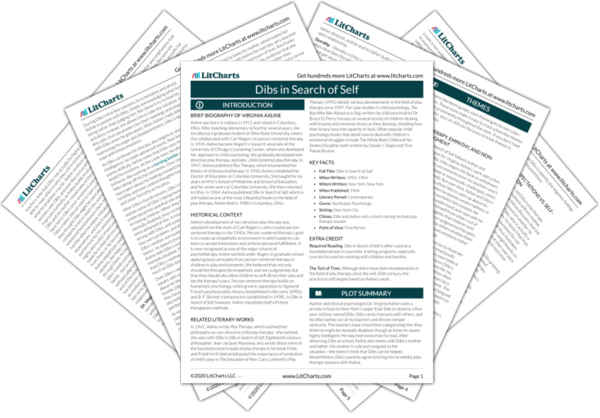Summary
Analysis
The following Monday, Miss Jane calls Axline, excited to report that the teachers have seen a big change in Dibs. She says that Dibs will answer them now and even initiate conversation. He refers to himself as “I” most of the time. Axline asks to have lunch, and she, Miss Jane, and Hedda meet the next day. The teachers no longer doubt that Dibs has been aware of and listening to everything going on around him. And he has even started to do what other children do in the room, like returning greetings and hanging up his hat and coat. Additionally, he no longer has temper tantrums and he smiles.
Affirming the report from Dibs’s mother, Dibs’s teachers reveal the benefits of his play therapy with Axline. They make concrete comparisons to his earlier behavior like not using “I” or throwing temper tantrums. Because Axline provided him with a safe and secure space, he was able to grow confidence in himself and then take that security with him outside of the playroom, just as she hoped. He is now a happier and more relaxed child, which benefits him and everyone around him.
Themes
Hedda also presents Dibs’s paintings (which are much simpler than the drawing that Dibs’s mother showed Axline the day before) and a few simple sentences he wrote like “I see a cat.” Hedda is excited by Dibs’s progress, but Axline wonders internally why Dibs is undercutting his abilities at school. She thinks these may be signs of Dibs adjusting to a group his own age. Hedda enthusiastically says that he can also read aloud, though very haltingly. Axline decides not to reveal Dibs’s true ability, worried that it would discourage the teachers. She hopes that Dibs will gradually be more comfortable being himself, but she believes at this point that his social adjustment is more important than displaying his intellectual abilities.
Axline understands that there is still a degree of conflict between Dibs’s emotional capabilities and his intelligence. Even as he starts to interact with others more, he is still holding his intellect back, showing that he’s not yet comfortable being himself. Yet just as Axline didn’t assure Dibs’s mother that he had superior intelligence in Chapter 8, Axline does not do so here. She knows that focusing on Dibs’s intelligence will only exacerbate some of his problems. Instead, Dibs needs to learn more social and emotional skills to let his intelligence flourish.
Themes
Hedda also says that Dibs has started to dance during the rhythm band, and that his mother seems much happier with him. On Dibs’s birthday, he sang along with the other children excitedly and passed out a piece of cake to each child. Axline is pleased with Dibs’s progress, but she hopes that in the future he’ll be able to use his abilities, not deny them. She knows his intellectual abilities were used to test him and that he became isolated as a result.
The story of Dibs’s birthday demonstrates that he has taken great strides in the social skills that Axline is trying to build. Still, she aims to eradicate the tension between the different areas of Dibs’s mental life. Rather than having his intelligence stifle his social skills, as happened with his mother, or his socialization stifle his intelligence, as is happening in the classroom, the goal is to make sure that Dibs can use both effectively.
Themes
Hedda also relays that Dibs acted in a school assembly, performing the part of the wind in a story and making up a song as he danced. The teachers and the children were thrilled that Dibs was part of the group, and Hedda thought that Dibs had found himself. Axline thinks that while this is great progress, there are many feelings Dibs has not dug out of his past yet. Axline wants to help Dibs further understand his emotions so that any hatred and fear he still has can be brought out into the open and diminished.
Dibs’s dance as the wind illustrates his newfound freedom of expression and his increasing social skills. This relates back to the story of the wind that he told in Chapter 9. In contrast to the tree, which was lonely and sad, the wind was able to travel anywhere it wanted. Dibs now identifies with that sense of freedom, and he uses that freedom to relate more to the other children. Axline hopes to continue to foster Dibs’s freedom by helping bring out more of his negative emotions and mitigating them.
Themes
Get the entire Dibs in Search of Self LitChart as a printable PDF.













